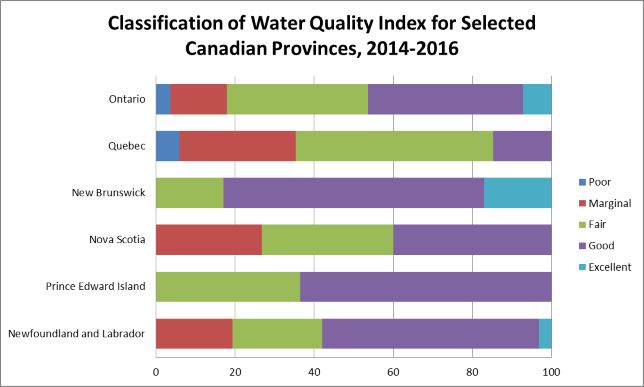Water quality in Central and Atlantic Canada

Healthy river ecosystems rely on clean water. According to a recent study, the quality of Canada’s fresh water is quite good. However, the study notes that results vary by region. To understand how water quality differs across the country, this blog post analyzes provincial water quality results in Central and Atlantic Canada.
The provincial data displayed in the chart below is based on the Environment Canada Water Quality Index (WQI). In particular, this index was developed by the Canadian Council of Ministers of the Environment (CCME) and used by the Environment Canada with a goal of summarizing complex water data and facilitating its dissemination to the general public.

The index measures a number of parameters (e.g. pH, SO4, NO3) in water and compares the parameters to water quality guidelines defined by the province or the federal government. Water quality guidelines are thresholds indicating when a parameter becomes harmful to animals and plants. The WQI accounts for the number of parameters that do not meet guidelines, the frequency of this occurrence, and by how much the parameters deviated from the guideline. Next, based on the overall suitability to support aquatic life, the index ranks water bodies as excellent, good, fair, marginal or poor.
Excellent means water quality is protected, with an absence of any threat or impairment. Good means there are only minor threats or impairments to water quality. Fair means water quality is usually protected but is occasionally threatened or impaired. Marginal means water quality is frequently threatened or impaired. Poor means water quality is almost always threatened or impaired
The chart shows the WQI results for Central and Atlantic Canada for the 2014-2016 period.
In Ontario, 28 stations were examined and rated using the WQI. Four per cent of stations were found to have poor water quality, 14 per cent had marginal, 36 per cent had fair, 39 per cent had good, and seven per cent had excellent. The Don River near Toronto is the only river in the province classified as having poor water quality.
Of the 34 stations in Quebec assessed and rated using the WQI, six per cent of stations were rated as poor, 29 per cent rated as marginal, 50 per cent rated as fair, 15 per cent rated as good, and none rated as excellent.
Overall, water quality ranges from fair to poor in southwestern Ontario and along the St. Lawrence River between Quebec City and Montreal, whereas it rates good or excellent in eastern Ontario.
Moving east to Atlantic Canada, according to the WQI calculated by Environment Canada, New Brunswick has clean surface water. Out of 53 stations, 17 per cent were classified as fair, 66 per cent as good and 17 per cent as excellent.
In addition, the calculations suggest that most rivers in Nova Scotia have good or fair water quality. Out of 15 stations, 27 per cent had marginal water quality, 33 per cent had fair and 40 per cent had good water quality. No stations were rated as excellent in the province.
Prince Edward Island maintains 11 stations, wherein 36 per cent were rated as fair and the remaining 64 per cent were rated as good.
Finally, Newfoundland and Labrador, which has 62 stations, reported almost half of the monitoring sites as good (55 per cent) or excellent (three per cent). Nineteen per cent were rated as marginal and 23 per cent rated as fair.
Overall, the state of water quality in Central and Atlantic Canada is quite good but some concerns remain in densely populated regions of southern Ontario and Quebec.
Authors:
Subscribe to the Fraser Institute
Get the latest news from the Fraser Institute on the latest research studies, news and events.

